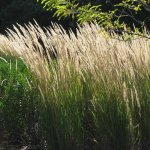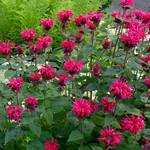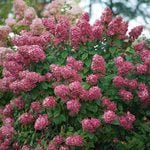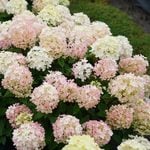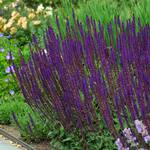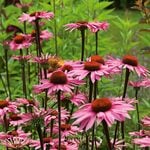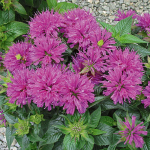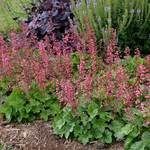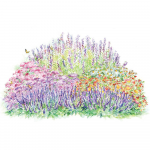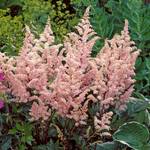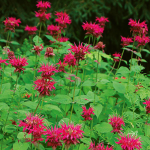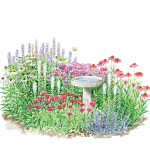Product Details
We're pleased to add royal purple to our palette of garden Phlox with P. paniculata 'Laura.' This mildew-resistant variety produces huge clusters of blooms with white eyes. A fine selection from the Minsk Botanical Gardens.
Phlox paniculata (Garden Phlox) is the species that earned Phlox its reputation as an indispensable garden plant, and it's worth your while to have as many as possible to enliven your garden in late summer. These upright, often fragrant, favorites produce generous flower clusters that add weeks of carefree color to gardens in summer and fall. Plants in the species flower in a spectrum of shades that ranges from whites to pinks and purples to blues and reds to oranges. Fragrant varieties emit a subtle, sweet, delicious perfume. Pollinators will take notice.
The varied, versatile, and indispensable Phlox genus includes almost 70 species of perennials and annuals. The majority of these low-maintenance plants are native to North America where they can be found in a range of habitats from woodlands and meadows to rocky alpine areas. All have tubular flowers that attract hummingbirds, hummingbird moths (also called hawk moths), long-tongued bees and butterflies. Most have a spicy vanilla-clove perfume that delights us as well.
For more information on growing Phlox, click Growing Guide.
How to see a 3D model of this item1. Click on the 3D Model image in the image gallery.
2. A pop up will open with the 3D model of the item. You can move the 3D model around with your mouse if on a computer or with your finger on your device. The 3D model represents a mature plant that is approximately 3 years old.
How to use (AR) Augmented Reality to see this item in your garden1. Make sure your device has a camera and is connected to the internet. If you want to see the item in your garden and are on your computer, click the 3D Model image on your computer and a QR code will open that will allow you to open the link on your device.
2. Once you have clicked the 3D Model image on your device, go outside and face your device camera toward where you would like to see how the item will look in your garden.
3. To see the item in your own garden, click on the [AR] link in the lower right-hand corner of the screen. You might need to wait a few seconds for the AR experience to load. This only works from a device with a camera such as a mobile phone or a tablet.
4. Allow your device to access the camera, if prompted.
5. Point your device's camera at the area where you want to place the plant or garden.
6. The website will use Augmented Reality to place a virtual image of the item in the space you are looking at through your device’s camera. You can adjust the position of the virtual item by using two fingers to resize the item, or one finger to move the item around the screen, until you're satisfied with how it looks. To get an accurate sense of the size of this item, we recommend measuring out the area where you would like to plant it (the spacing for this item is 18"), and staking or flagging the borders so that you will have an accurate idea for the mature size of the item while using AR (the magnifier only enlarges the 3D model of the item, it does not change the actual size of the item). The 3D model represents a mature plant that is approximately 3 years old.
7. Move your device around to view the item from different angles and get a better idea of how it will look in your garden.
8. Once you have everything lined up, take a screenshot or tap the screen to show the AR experience controls and press the white circle to take a photo of the AR image to save it for future reference.
9. If you decide to purchase the item, you can use the AR image as a reference for placement in your garden.
Shipping
HOW PLANTS ARE SHIPPED
The size of the plants we ship has been selected to reduce the shock of transplanting. For some, this means a large, bareroot crown. Others cannot travel bareroot or transplant best if grown in containers. We ship these perennials and annuals in 1 pint pots, except as noted. We must point out that many perennials will not bloom the first year after planting, but will the following year, amply rewarding your patience. We ship bulbs as dormant, bare bulbs, sometimes with some wood shavings or moss. Shrubs, Roses, vines, and other woody plants may be shipped bareroot or in pots. The size of the pot is noted in the quick facts for each item.
WHEN WE SHIP
We ship our bulbs and plants at the right time for planting in your area, except as noted, with orders dispatched on a first-come, first-served basis by climate zone. We also ship a wide range of containers and planters, tools, supplies, fertilizers, garden wear, garden decor items, as well as indoor decorations like wreaths and dried bouquets when available. Estimated dates for shipping are indicated in the green Shipping Details box for each item. Please supply a street address for delivery. Kindly contact us with two weeks notice, if you'll be away at the expected time of delivery.
OUR GUARANTEE
We guarantee to ship plants that are in prime condition for growing. If your order is damaged or fails to meet your expectations, we will cheerfully replace or refund it. Please contact our Customer Service Department at 1-800-503-9624 or email us at [email protected]. Please include your order number or customer number when contacting us.
Reviews
Average Customer Rating:
 (5 Reviews)
Write a Review
(5 Reviews)
Write a Review
Sort by:
beautiful color 
A viewer from Wichita Ks
Despite especially bitter cold winter this yr, they are all coming up nicely.
The color has been stunning, much prettier than picture.
Also long blooming season. Did not have to stake, maybe bec I planted sl.deeper and had mulch around the plants.
20 of 20 people found this review helpful. Do you? yes no Certified buyer
Perfect in Zone 9 
A viewer from CA
70 of 70 people found this review helpful. Do you? yes no Certified buyer
Growing guide
Latin Name Pronunciation: floks
This important genus of valuable garden plants includes reliable and colorful species that bloom both early and late, in sun and shade, and in a range of rich colors that is equaled by few other genera. Most Phlox grow best in full sun (or partial shade in the South) and moist, well-drained soil.
P. divaricata laphamii is at its best in partial shade and in well-drained soil enriched with organic matter. Plants prefer soil with a slightly acid to neutral pH. They have an informal habit and root where the stems touch the ground, allowing them to form a ground cover where conditions suit them. Cut flowering stems to the ground after the blooms fade to keep plants looking tidy.
P. paniculata and, to a lesser extent, P. carolina and P. maculata are susceptible to powdery mildew, especially in dry soil. Water deeply during dry spells to reduce the incidence of disease, and dust with sulfur (available at most garden centers) beginning in early summer. Thinning half of the shoots when 6″ tall in spring (to allow better air circulation) also helps keep mildew at bay and encourages plants to produce larger and longer-lasting flower heads.
Divide P. paniculata every few years, replanting sections from the edge of the clump and discarding the woody center.


